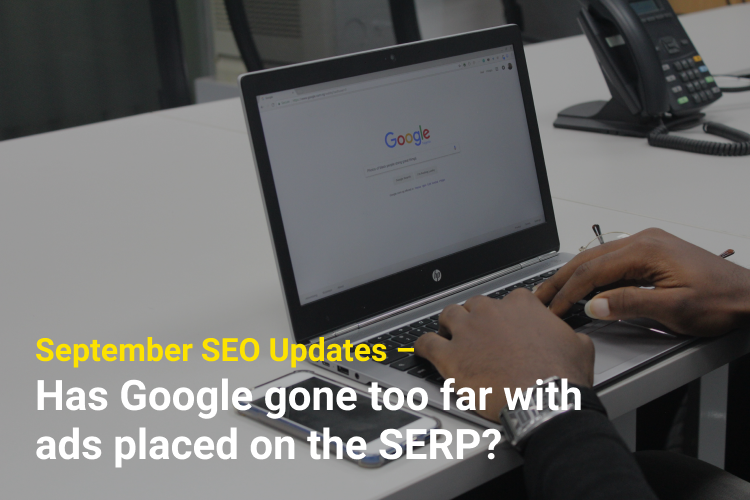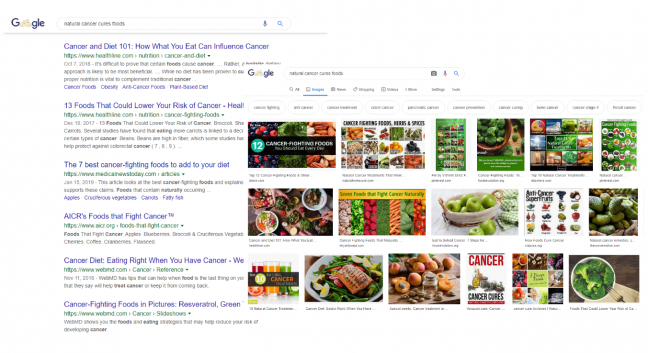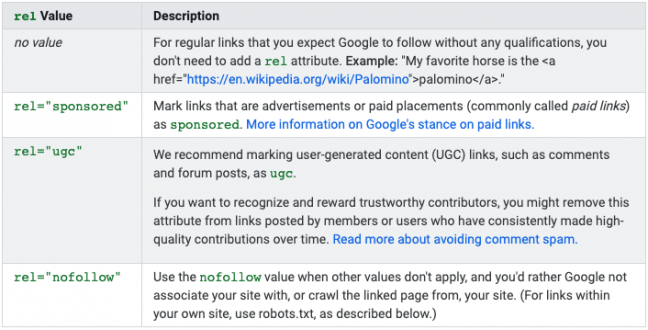
- Algorithm Updates
- Google Announcements
- SERP Updates
- Local SEO and Google Maps Update
- Other Interesting News
Welcome to a new month! Hope you’ve been enjoying our weekly updates and would look to hear your thoughts on the series so far. Leave us a message below even if it’s just a HELLO!
Now let’s jump right in to see what’s happening in the SEO industry this week.
Algorithm Updates
04/9/2019 – Suspected link quality updates by the Mary Haynes team.
SEO expert Mary Haynes observed a spike in organic traffic for sites that has previously disavowed bad links following the team’s suggestion. While the opposite happens to some of the sites who did not follow through with the same advice.
Though it is still too early to be sure, the team advise webmasters to review their backlink profile and disavow any bad links in the case that organic traffic starts dropping last week.
They recall that John Mueller from Google affirms the usefulness of disavowing bad links and maintaining a clean and organic backlink profile earlier this year.
To quote Mueller: “So it’s something where our algorithms when we look at it and they see, oh, there are a bunch of really bad links here. Then maybe they’ll be a bit more cautious with regards to the links in general for the website. So if you clean that up, then the algorithms look at it and say, oh, there’s– there’s kind of– it’s OK. It’s not bad.”
Google Announcements
9/9/2019 – Google Search Quality Rater Guidelines gets Updated on September 5th
Google has updated the Google Search Quality Rater Guideline handbook on September 5th – that is four months after it has last updated the guidelines on May 16, 2019.
The live guideline document is now one page thicker than last time at 167 pages, and you can read the full document here.
But long things short – here’s everything you need to know about the changes in Google Search Quality Rater Guidelines updates:
1. Google has placed a huge emphasis on Original Content
In several places, the QRG has changed to emphasize the importance of having original content.
This correlates with one of Amit Singhal’s 23 questions on Google Webmaster that concerns a site’s quality, which is:
Does the article provide original content or information, original reporting, original research or original analysis?

2. Google sees the use of Original Images and Videos as a Sign of High Quality
In the “Very High-Quality Main Content” section, it reads:

Currently, a search query of “natural cancer cures food” displays different results on Google whereby Google search shows trusted websites like Healthline and WebMD while the same query on image search shows more alternative health websites.

Based on this update, it would seem that moving forward that Google will most likely start applying E-A-T (Expertise, Authority, and Trustworthiness) filters to an image search for YMYL queries.
3. Clarification on what YMYL – Your Money Your Life – means
Google also made a few clarifications on YMYL pages, describing them as “type of pages or topics that could potentially impact a person’s future happiness, health, financial stability or safety.”
There’s also differences in terms of YMYL examples and one important info for shopping/ transactional websites:

This statement may possibly show that Google will put more emphasis on reviews that come from actual users of your products.
12/9/2019 – Google adds two new link attributes – “sponsored” and “ugc”
BIG News. Google yesterday has revealed two new link attributes – rel=”sponsored” and rel=”ugc” in addition to the rel=”nofollow” link that was introduced in 2005.
Here’s the description for each link attribute:

Basically, the two new link attributes serve further clarity to the rel=”nofollow” link attribute that lets Google identify if the content is a paid placement or user-generated content. But what, we SEOs don’t understand is why?
More specifically, we don’t understand what are the incentives for making these changes in the site, and it most certainly did not help when Danny Sullivan added that it is perfectly fine to leave your nofollowed links as they are and just ignore the two new options.
How can they put teeth into it? "You used nofollow on sponsor links, instead of rel="sponsor", which is now a violation of our policies"? Seriously, you think they will go there?
— Alan Bleiweiss (@AlanBleiweiss) September 10, 2019
So, in most cases, nothing has changed. Still, SEOs speculates that the most important part of the whole announcement is not adding the new link attributes but that Google is treating rel=”nofollow” as a hint now, which might be taken into consideration.
SERP Updates
05/09/2019 – With mobile first indexing, Google more likely to show the M-DOT version of your website on desktop search
John Mueller from Google touched on the topic of M-DOT sites on this week’s Google webmaster hangout video.
He phrased it as an “unstable situation” where sites having mobile first indexing may be shown their M-DOT site, even when the search is done on desktop and not mobile.
To fix that, Mueller suggests redirecting desktop users to the correct desktop site, so Google can better understand the situation in the case they didn’t catch it at first.
At the end of the day, Google still recommends adopting responsive design to handle desktop and mobile users.
Here’s the video of Mueller discussing the issue.
Local SEO and Google Maps Update
05/09/2019 – Google My Business retiring distance-based service area
Previously, business owners can set a service area based on a distance around their physical location. But now, Google is retiring that option and business owners will have to choose a closest named area instead.
Listings still using the distance based service area will be automatically converted to the closest named areas.
The move of retiring the distance based area was started since last November, so business owners are actually given ample time to edit and update their GMB listing.
Nevertheless, Google will be sending out notification emails about the change.
Other Interesting News
04/09/2019 – All is fair game in Google Ads
Base Camp CEO Jason Fried tweeted his dismay on having to compete for his own company name for SERP real estate.
Making users scroll through not one not two but four paid ads before getting to the company website they are specifically searching for is probably stretching the term – efficient user experience.
Though we understand that such ads are handled by the GoogleAds team, it’s still disheartening seeing companies having to compete for their own brand name. Though easily solved with some dollar bills.
To provide users with the most relevant ads, we don’t restrict trademarked terms as keywords. We do restrict trademarked terms in ad text if the trademark owner files a complaint here: https://t.co/J1P7oJ5BTN
— Google Ads (@GoogleAds) September 4, 2019
The GoogleAds team did try to offer an olive branch, but it only fuels more witty pokes from the enraged.
How generous of you to let us manually flag trademark violations! We'd hate to be burdened with the automated system you use to protect your own trademarks. pic.twitter.com/AoWzbgthX4
— Adam Stoddard (@AdamStddrd) September 4, 2019
Fair game the big G said.
06/09/2019 – Google adds new structured data documentation for movie
New structured data incoming! Google is constantly pushing for the implementation of structured data and also keen on providing tools and new markups to help webmasters to get a little bit more edge in the SERP.
They announced the new markup via Twitter, check out the documentation here if you’re interested.
"You can't handle the markup!"
There's new structured data documentation for Movie carousels
: https://t.co/JU6iGtPi5x
— Google Webmasters (@googlewmc) September 5, 2019
#optin-template-3{
float: left;
margin: 0;
width: 100%;
max-width: 654px;
height: 100%;
}
#optin-template-3 .container{
float: left;
width: 100%;
height: 100%;
text-align: center;
background: #fff;
border: 0px solid #4a78bd;
padding-bottom: 16px;
}
#optin-template-3 .top-row{
display: inline-block;
width: 88%;
padding: 3% 6% 0%;
}
#optin-template-3 .top-row h2{
margin: 5px 0 0;
font-family: “roboto”, helvetica, sans-serif;
color:#4a78bd;
font-weight: 600;
text-align: center;
padding:0px 0px 5px;
font-size:2.2em;
}
#optin-template-3 .left-column{
display: inline-block;
width: 100%;
max-width: 270px;
min-width: 270px;
height: 100%;
vertical-align: top;
padding-top: 32px;
}
#optin-template-3 .ebook-img{
width: 100%;
min-width:270px;
height: 330px;
background: url(https://seopressor.com/wp-content/uploads/2016/07/Best-Strategy-To-Rank-On-Google.png);
background-size: cover;
}
#optin-template-3 .right-column{
display: inline-block;
width: 60%;
min-width: 250px;
max-width: 305px;
padding: 24px 4% 32px;
}
#optin-template-3 .bodycopy ul{
text-align: left;
padding-left: 0;
}
#optin-template-3 .bodycopy ul li{
font-family: “roboto”, helvetica, sans-serif;
margin-left: 20px;
}
#optin-template-3 .optIn-form{
display: block;
bottom: 0;
}
#optin-template-3 .email{
display: block;
width: 100%;
border: 0;
padding: 8px 0;
font-size: 18px;
text-align: center;
border: 1px solid #4a78bd;
}
#optin-template-3 .submit-button{
display: block;
margin-top: 4%;
width: 100%;
padding: 8px 0;
font-family: “roboto”, helvetica, sans-serif;
font-weight: 400;
color: #fff;
background: #4a78bd;
font-size: 21px;
border: 0;
outline: 1px solid #4a78bd;
cursor: pointer;
}
Best Strategy To Rank Your Content On Google
- 3 In-Depth Research On Ways To Get Ranked On Google
- 5 Effective Ways To Drop Your Bounce Rate
- 7 Unexpected Results From The Case Studies
- Rank Your Content With Not Just One, But Multiple Keywords
- Best Practice To Bring Back Your Lost Traffic

 "You can't handle the markup!"
"You can't handle the markup!" There's new structured data documentation for Movie carousels
There's new structured data documentation for Movie carousels  :
: